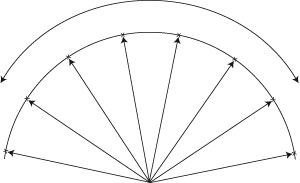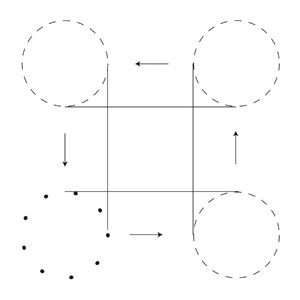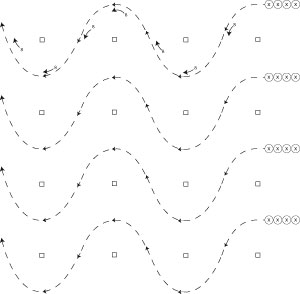As students report to band camp in August, each director again faces the task of getting the feet of inexperienced marchers to move in coordination with lips and hands. There are many choices to make about how to run camp, including how much time to work on basics, whether to separate freshmen from upperclassmen, and when to start teaching drill. Marching band has evolved over the years, and it is necessary to teach block band alongside contemporary movement.
I teach spatial awareness basics, which means that each performer understands his relationship to the next performer at all times. Although I teach initially by dot-to-dot, using poker chips or chalk marks, once set points are established performers must understand form relationship. If the dots aren’t correct, students should know how to adjust and use common sense. This doesn’t mean to dismiss the set points; instead, teach performers how to think through problems in spatial relationships. There are five things students should know:
• The concepts of balance and uniformity of the body from a dancer’s perspective rather than a military one.
• How to watch and listen to each other.
• Methods of recovery from error and how to think their way through problems that arise.
• How to perform simultaneous tasks. This should be learned very early in the year.
• How to keep visual contact by drill, location, speed, and set points.
I start by teaching individual marching skills, focusing on how the body should feel. Attention should be a centering of the body. For mark time, determine whether the heel or the toe should hit on the downbeat. Step-offs should be clearly defined. Teach either by elevating the knee (lift and plant) on the first step or locking the knee for a smooth entry into the glide step. In both cases, students land on the heel and roll the foot forward into the glide step. When doing a glide step, the key is foot and leg control; there should be tension on the back part of the legs from the glutes on down. For marching flanks, the focus should be on weight and balance. These exercises help develop the techniques that define the style of your band. Display of style is an important factor to the success of a marching band.
When students have the basics of marching down, we move on to interaction, taught best in block band. Interaction on the field with other band members is where spatial awareness becomes necessary, but students need first to learn what it is they have to be aware of. Dress is the straightening of an imaginary line running from the shoulder of one person to the shoulder of the next.

Curvilinear dress is done by the performers facing a focal point and lining up their shoulders.

Interval is another form of interaction and refers to the space between performers from right to left in a straight line or a curvilinear line based on the focal point. Cover simply means pointing your nose in the middle of the center of the person in front of you in a file, and distance is the space between performers from front to back in a file. Slides refer to turning the upper torso, thus directing the sound and visual effect by projecting the audio to the audience and keeping everyone facing forward. The key to getting students thinking while working on these things is to come up with exercises in which students have simultaneous responsibilities. Even if the band is simply marching 8-to-5, students could clap syncopated rhythms or turn their heads right or left on certain counts.
A good way to teach spatial awareness is through form maintenance. To practice holding a form, have students make a circle, move it 16 steps to the right, turn in 4, move 16 steps forward, turn in 4, 16 steps to the left, turn in 4, and march the last 16 steps back to the starting position.

Another good exercise is called the traffic test, which teaches the principles of traditional dress, cover, interval, distance, and curvilinear pathways.

First, create set points with a 4×4 grid of folding chairs set 10 steps apart. You could also use colorguard members instead of chairs for an interactive exercise. Band members step off in a curvilinear path and in eight counts will come into a file or cover position facing forward. In the next eight counts they go between the chairs and come to a dress position in which they can practice judging space by location. Eight counts later students are back in a file position facing the other direction. Every eight counts a new band member steps off, and when someone reaches the end he runs back to the beginning to get in line.
The best exercises make students think about multiple things all at the same time – environmental difficulties, path, location, dress, cover, interval, distance, and speed. The more simultaneous responsibility placed on students, the more quickly they learn to think about what is happening around them and how to react to it.






